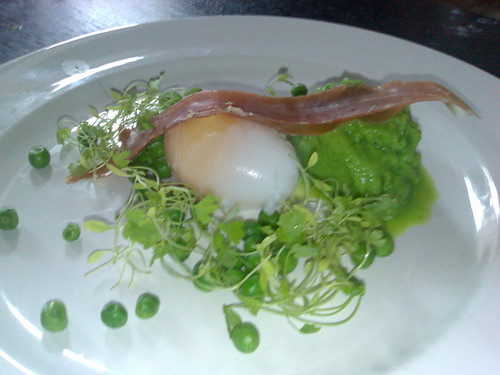Sunday, May 27, 2007
Sat Bains' Ham, Egg, and Peas

While everyone else is obsessing over Heroes, Lost, and Prison Break, I've been meticulously TiVoing Great British Menu. It's a very British, very restrained version of Iron Chef. The winning starter from this series, was Sat Bains' Ham, Egg, and Peas. Uniquely it got full marks from the judges, perhaps because it looks good, and represents a witty molecular gastronomy reworking of a working class British classic dish. It is also the dish that used the most bits of expensive kit, which immediately made me want to try it at home. The recipe on the BBC website is rather over-simple, so I've annotated it below.
1. To make the pea sorbet, bring the liquid glucose and 200ml/7fl oz of water to boil in a saucepan to make a stock syrup. Add the frozen petit pois and mint. Allow to cool slightly and then pour into a food processor or blender. Process on high speed to make a purée. Chill, then pour into an ice cream machine and churn for 20-30 minutes or until the sorbet reaches a soft-scoop ice cream texture. Taste for seasoning and adjust with a pinch each of sugar and salt if necessary. Transfer to a freezer container and freeze.On TV Sat Bains made the sorbet using a £2500 Pacojet. The Pacojet produces an entirely smooth puree that can't really be reproduced using a home blender. I Magimixed my pea puree, and then strenuously passed it through a tamis, before adding it to the ice cream maker. Copying El Bulli, I dressed the scoops of pea sorbet with fleur de sel.
2. Next, poach the eggs. A rice cooker is the best thing to use, but if you don't have one, heat a pan of water to around 62C/143F, ideally monitoring the temperature with a digital probe. Carefully add the eggs in their shells and leave at 62C/143F for about 1½ hours - the whites will be just firm and the yolks runny. Remove the eggs with a slotted spoon and set aside.I've experimented a lot with slow cooked eggs, and as far as I can see, a rice cooker is too hot. I use a wide pan on an electric hob, on the lowest setting. I monitor the temperature with a digital meat thermometer. If you pierce a cork with the probe, you can have it float in the water easily. Setting it to "medium rare beef" will let it alarm whenever it starts to get too hot. Sat Bains had his water bath set to 60.9 degrees C, but the eggs come out fine anywhere between about 60 and 65. Fresh eggs are really important not just because of salmonella, but because it's much harder to peel such soft eggs, especially if they are a few days old. I used Clarence Court Braddock Whites.
3. Preheat the oven to 180C/350F/Gas 4. Arrange the bread slices on a large baking sheet, brush with olive oil and bake for about 12 minutes or until golden-brown.I couldn't find pea shoots anywhere, so I substituted celery shoots. Fortuitously we had picked up air dried ham on our trip to L'Enclume, in the Lake District. The overall dish is a real success, and ideal for a dinner party, because almost evertthing can be prepared in advance. It's the best breakfast I've had this week.
4. Pour the chicken stock into a medium saucepan and add the butter, shelled peas and a good pinch of salt. Simmer gently for 3-4 minutes to braise the peas until tender.
5. To serve, carefully peel the shells from the duck eggs. Spoon the braised peas into the centre of warmed shallow soup bowls. Sit the eggs on top of the peas. Lay a slice of ham over each egg, and arrange a spoonful of pea sorbet to one side. Lay a couple of pieces of toast on top of the ham. Dress the pea shoots with a drizzle of olive oil and a sprinkling of salt, then scatter them all around.
Subscribe to Comments [Atom]